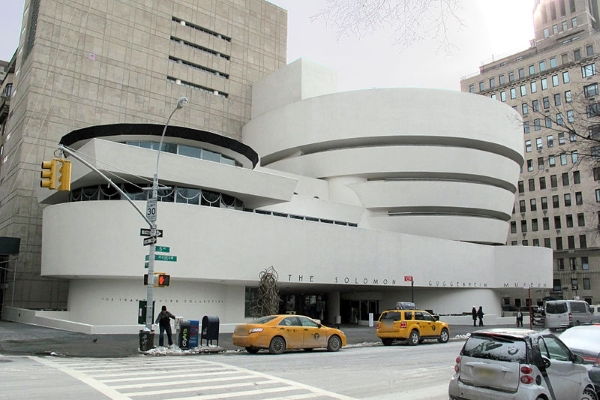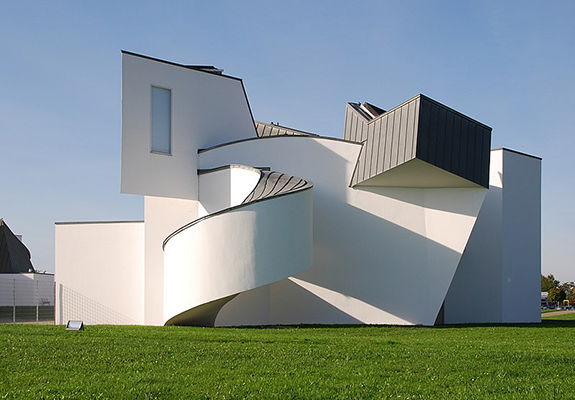Summary of Zaha Hadid
First woman to break the glass ceiling of the "Starchitect" universe, dwelling amongst greats such as Frank Lloyd Wright and Le Corbusier, Iraqi-born Zaha Hadid's pioneering vision challenged notions of what could be achieved in building. Coined the "Queen of the Curve," her highly inventive designs liberated architecture from its traditional treatment of concrete and steel and introduced radical new ways to envision spaces in synchronicity with their surroundings. With a foundation in painting and the utilization of progressive digital technologies, Hadid's creativity was unbound by existing typologies and her innovative approach helped shift the geometry of buildings toward a radical new aesthetic.
Accomplishments
- Before ever seeing one of her designs realized as a physical building, Hadid's architectural drawings and paintings were gaining her international acclaim. Through wildly imaginative and intricate abstractions, she was already questioning the idea that a building was merely a solid mass, paying attention to the relationships between its individual elements.
- Although not aligned with any particular school, much of Hadid's work has been linked to Deconstructivism in its sculptural treatment of architecture as a container for interconnective spaces, dramatic untraditional angles, and volumes bursting with many little pieces. In this way, her realized buildings echoed her earlier paintings.
- Her consistency with questioning the status quo led Hadid toward the development of new digital techniques that allowed her to depart from the standard horizontals and verticals and to reimagine the structural engineering of bold new forms. Her firm would coin the term Parametricism to define this signature look and feel.
- Hadid's position as a world-renowned architect dedicated to her career above all else was further emphasized by the fact that she was a woman and a Muslim. Bold, unapologetic, and progressive, she helped bash stereotypes while infiltrating a field that had largely held a longstanding reputation as a male-held profession.
The Life of Zaha Hadid
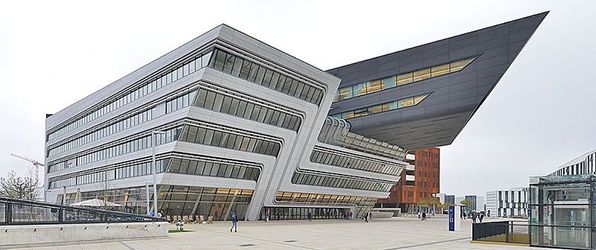
When British journalist Simon Hattenstone met Zaha Hadid at her east London home, he compared her to the Queen of Hearts, roaring “off with their heads” at her subordinates. “She is a fantastic monster, uncompromising dictator of her own wonderland, and one of the world's great architects,” he wrote.
Important Art by Zaha Hadid
The Peak Blue Slabs
This painting was made in the early years of Hadid's career as an architect, before any of her designs had been constructed. It shows her un-built yet competition-winning design for a private leisure club - The Peak - on a mountainside in Hong Kong. The painting emphasizes the sympathetic relationship between the jagged edges of the leisure center and those of the mountain, and positions the building within the topography of the site. The flat surface of the painting acts to remove any boundary between building and landscape - a distinction that Hadid remained interested in blurring throughout her career.
Inspired by the Russian Suprematist painter Kazimir Malevich's abstract geometric paintings, the piece explores Hadid's three-dimensional subject matter in this two-dimensional work, demonstrating her interest in spatial relationships. The architect spoke of how Malevich's paintings helped her to use abstraction as a way of investigating different designs. According to the curator Hans Ulrich Obrist, "Her buildings may be made of metal, glass and concrete, but their building blocks are her sketches, drawings and paintings."
During this period, and throughout her career, Hadid used painting as a method of representing her building designs in the abstract, often showing them as a disassembled collection of parts, which was a signature of Deconstructivism. She described The Peak in this painting as dissolving into a "confetti snowstorm." Her view was radical as it departed from the conception of buildings as solid masses. Rather, the elements of the building are suspended in the landscape as if extending or exploding from it. According to Obrist, the painting has "the idea of zero gravity, a kind of floating - that is the incredible thing she achieves."
The Peak Blue Slabs was on display at the exhibition Zaha Hadid: There Should Be No End to Experimentation in 2017 at the Serpentine Gallery. Here, her drawings and paintings were shown as artworks in their own right.
Acrylic on canvas - collection unknown
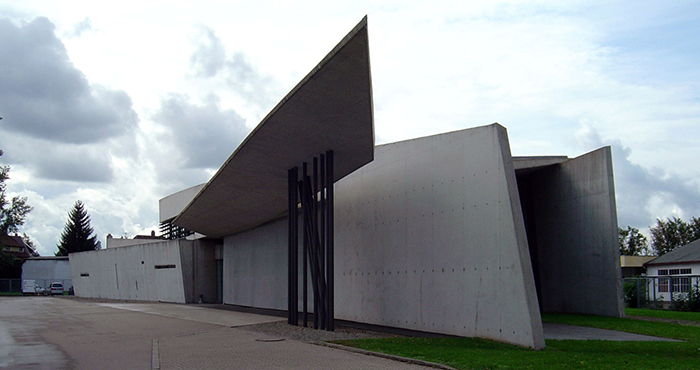
Vitra Fire Station
The Vitra Fire Station was Hadid's first built work, though she had already made her name as a "paper architect" on account of her creative and ambitious architectural drawings. The client was Rolf Fehlbaum of the Swiss furniture firm Vitra, who would become a member of the jury for the prestigious Pritzker Architecture Prize in 2004 (the year it was won by Hadid). In 1989, Fehlbaum had commissioned Frank Gehry to build a design museum at the Vitra factory in Weil am Rhein, the first of several buildings by notable architects that now make up the Vitra campus. The following year, Hadid won a design competition to create a small fire station for the factory (which had experienced a major fire in 1981).
Hadid's design was entitled "Movement Frozen," which could refer both to its dynamic geometry (some critics have likened its form to a bird in flight) and its being alert to respond to an emergency by bursting into action at any time. It employs glass and concrete block in angled planes that appear stretched, as if in perspective. According to the Architectural Review, these sharp angles and pointed features such as the entrance porch demand our attention and connote a sense of urgency. Cast on site, according to architectural photographer Hélène Binet, it demonstrated new possibilities for working in concrete: "[Hadid] created an incredible signature. Concrete became something else... after her."
The walls and planes are arranged in layers, with the functions of the building dispersed between them. These include areas for fire engines, changing rooms for firemen, a conference room and a kitchenette, all connected by internal streets. There are few pure horizontal or vertical planes, which can disorient those who inhabit the building. This sense is also reinforced by the lack of color. Journalist Harry Mount concurs, "Its shrieking concrete angles and disruptive interiors photographed very well and were dutifully recorded in the magazines, but were not much liked by the firemen. It was decommissioned and is now an exhibition centre."
The latter statement is due to the fact that a new public fire station was opened in the area of Weil am Rhein. Nevertheless, the Vitra Fire Station served its purpose for Hadid of launching her career as an architect of built works. It now functions as an exhibition and event space for the Vitra design museum, while remaining in the care of the Weil am Rhein and the Basel fire services with respect to maintaining the building. It remains a prime example of Hadid's commitment to challenging the status quo, both in presenting a work of unusual complexity to house a familiar public service, but also in her re-envisioning the angular by breaking it out from its typical 45 or 90-degree mold.
Weil am Rhein, Germany
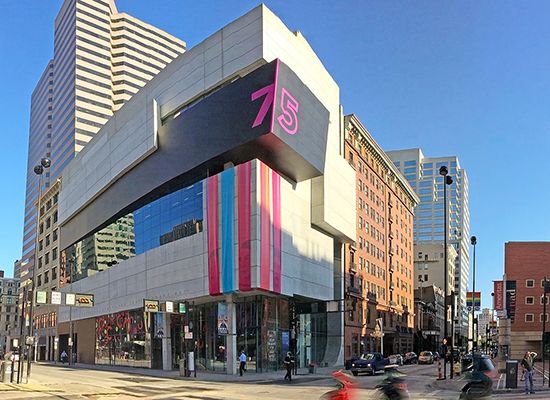
Lois & Richard Rosenthal Center for Contemporary Art
The Center for Contemporary Art (later the Lois & Richard Rosenthal Center for Contemporary Art), founded in 1939, was one of the first of its kind in the United States. Its initial premises, although central, had little visibility to the street and so a design competition was held in 1997 to create a new presence for the center. Hadid's competition entry proposed several gallery volumes, suspended from a concrete plane. This arrangement would inform both the interior and exterior of the building. The gallery spaces are variously shaped and sized and with different lighting strategies, to accommodate a range of contemporary art pieces. Hadid called the arrangement of galleries the "jigsaw puzzle" to describe how the different volumes slotted together.
The given site for the new building, a busy street corner in downtown Cincinnati, also helped to inspire the design. The facade to the street is translucent, inviting passers to look inside, and breaking down the stereotype of the museum in general as remote and uninviting. One critic commented, "This is a building that does not so much sit on its street corner as continuously arrive there."
In this same vein, Hadid developed the idea of an "urban carpet" to create continuity between the museum and the street, thus driving footfall into the building. By this it is meant that the ground floor of the building functions as a public square, albeit enclosed by glazing. The surface of this floor curves upwards as it meets the wall, as if to invite visitors up into the gallery spaces above. This sense of movement continues throughout the museum, as various lighting conditions in different areas create "channels of light," which draw visitors through the space.
At the building's opening in 2003, it was the first American art museum designed by a woman and it was also Hadid's debut in the United States. "[It is] the most important American building to be completed since the end of the Cold War," said architecture critic Herbert Muschamp. He went on to praise the building's "cosmopolitan values" which he also believed to be embodied by Zaha herself (perhaps on account of her multi-cultural and international upbringing).
Cincinnati, Ohio

MAXXI Museum
The MAXXI Museum is Italy's first national contemporary art museum. Its building is therefore significant as it offers a contemporary identity for Rome that complements the city's classical heritage. The actual museum is only one of five structures that made up Hadid's winning competition design, which was based around the concept of a "field of buildings." As such, she has referred to the project as "incomplete."
In designing the museum, Hadid responded to the gridded layout of the site's surrounding classical buildings, while also introducing her trademark Deconstructivist style. It features curved concrete walls, suspended staircases, a black and white color scheme, large glass openings, and overhanging elements. As architecture critic Rowan Moore noted, the "bending oblong tubes, overlapping, intersecting and piling over each other" are reminiscent of transport architecture.
With this design, Hadid was aiming to achieve "a new fluid kind of spatiality of multiple perspective points and fragmented geometry, designed to embody the chaotic fluidity of modern life." In other words, the building was to represent contemporary Rome and to be flexible to its needs.
In line with this intention, Hadid designed the building as a flow of joined-up spaces that can accommodate a variety of artworks and temporary exhibitions, a move away from the "boxing off" of spaces that is more traditional of museums. As a result, some critics argued that the museum was more suited to sculpture and installation than to 2D works. (The same criticism was lobbied at Frank Lloyd Wright's Guggenheim Museum in New York, by which Hadid was inspired.)
It was important to Hadid that the building serve "not [as] an object-container, but rather a campus for art," reflecting her understanding of the museum's role in contemporary life as well as the institution's goal to preserve cultural objects. The lighting and circulation reinforce this notion of activity, as suspended, lit staircases appear to "fly across a void," guiding the visitor through the contemporary art program.
Rome, Italy
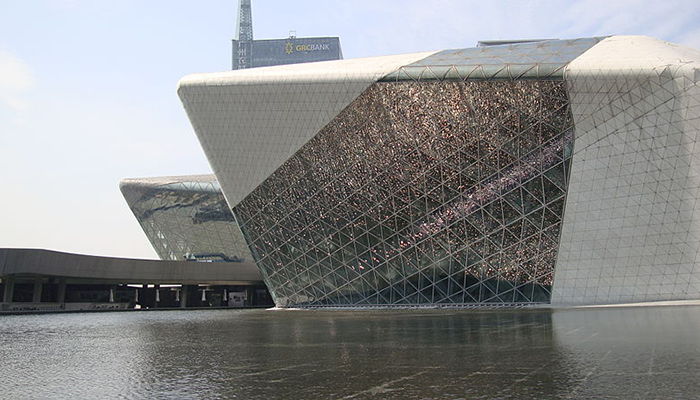
Guangzhou Opera House
The Guangzhou Opera House was Hadid's first project in China and resulted from her success in a design competition. A folded structure in glass and polished granite, it comprises a 1,800-seat theatre, 400-seat multifunctional hall, rehearsal rooms and an entrance hall.
Hadid described the building as "like pebbles in a stream smoothed by erosion", emphasizing the way in which the materiality of the building responds to its riverside location. Continuing this theme, the main auditorium is lined with reinforced plaster panels in a folded surface that resembles "the soft insides of an oyster". Unfortunately, some critics have pointed out that Hadid's references to erosion are apt, given that the building has suffered on account of poor workmanship. The quality of the plaster and other interior work was found to be lacking, and around a year after opening, many of the granite panels on the exterior had to be replaced.
The response of critics to the design of the building has been mixed. Architecture critic Nicolai Ourousoff called it "a Chinese gem that elevates its setting", whilst architect Edwin Heathcote suggested the building both transforms the landscape in a positive way and appears "alien" and "incomprehensible". Heathcote's view is fitting inasmuch as the building sits within a newly developed area of Guangzhou and has prompted the construction of further cultural facilities, such as museums and libraries. Inspired by the riverside surroundings, it nevertheless introduces innovation and the unknown. Reflecting this spirit, the decision was taken to perform Puccini's opera Turandot - considered a controversial work of art and to that point never performed in China - at its opening.
Guangzhou, China

London Aquatics Centre
The London Aquatics Centre is part of the Queen Elizabeth Olympic Park in Stratford, London. It was one of the main venues of the London 2012 Olympic and Paralympic Games, during which it was used for the swimming, diving and synchronized swimming events. Moveable elements allow the size and depths of the different pools in the complex to be changed.
The roof is one of the most striking features of the building and takes the form of a sweeping parabolic arch. Constructed from steel and aluminum and clad in wood on the inside, it rests on just three concrete supports and connects the two pools at each end of the building. Hadid described the form as "inspired by the fluid geometry of water in movement", whilst architecture critic Rowan Moore concurred that the roof "floats and undulates". He called the center "the Olympics' most majestic space".
The Aquatics Centre was the first 2012 Olympic building to enter construction but the last to be completed. Cost concerns that required several revisions played a key part. At £269 million, the building cost more than three times its original estimate, largely owing to the complexity of the roof - though costs were also added to account for the transformation it underwent after the Olympic and Paralympic Games.
After the Games, the spectator wings on either side of the central space were removed and sold, whilst other parts of the building were re-used (for example the seats and toilets) or re-cycled. The building re-opened in March 2014 and has been used for several other sporting events, including the 2014 FINA/NVC Diving World Series and the 2016 European Aquatics Championships.
London
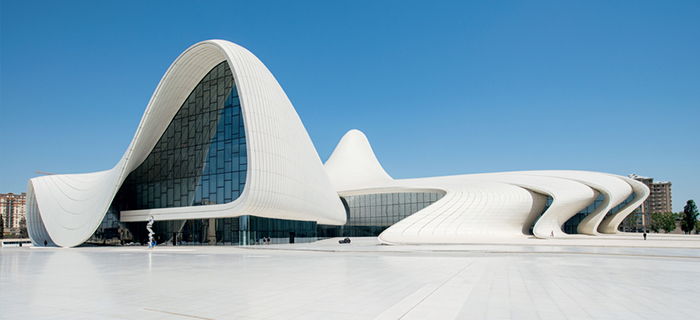
Heydar Aliyev Cultural Center
The Heydar Aliyev cultural center - named after the controversial former president of the Azerbaijan Republic - has become a signature of the redevelopment of the city that began with the country's independence in 1991. Hadid was appointed as the design architect for the center after a competition in 2007. It is an example of her Parametricist style, which uses digital animation techniques of the late 90s to structurally engineer the building and compute its forms.
The center houses a museum, 1000-seat auditorium, multi-purpose hall, temporary exhibition spaces, a conference center and workshops. Each of these functions is represented by a fold in the surface of the building, thus each has its own identity but is also part of a continuous whole. Computer systems helped with the practical and technical challenges of creating a continuous surface at this scale, while taking into consideration future temperature fluctuations, seismic activity and other potential environmental and societal effects.
In 2014, the Heydar Aliyev cultural center won the Design Museum's Design of the Year Award 2014, making Hadid the first female winner. One judge described the building unconventionally as: "as pure and sexy as Marilyn [Monroe]'s blown skirt", whilst The Guardian adds that it appears: "Like sinuous whirls of whipped cream, buffeted into a mountain range of peaks and spilling out to form a zigzagging landscape".
The sweeping surfaces were appropriate to this project, since a key part of the regeneration of Baku was moving away from the monumental style of Soviet architecture towards more flowing forms. According to Hadid's practice, these recall Islamic architecture with its continuous calligraphy and ornamental patterns that connect architecture, interior and landscape. With this in mind, the building appears as a continuation of the surrounding plaza, the surface of which seems to rise up into its folded form. A public interior space on the ground floor adds to this sense of continuity and invites the outside in.
Hadid has spoken of the project's ambition and its capacity to reflect the romance and optimism of independent Azerbaijan. However, sitting uncomfortably alongside these values are criticisms from human rights groups, who claim that hundreds of local people were forcibly evicted from their homes on the site. This has led some to question the ethics of Hadid's practice, particularly in the wake of contemporary reports on poor working conditions on construction sites for her Al Wakrah Stadium in Qatar.
Baku, Azerbaijan
Biography of Zaha Hadid
Childhood
Zaha Hadid was born in Baghdad, Iraq during a period of prosperity in which the government chose to invest in modernizing the city's architecture. Her childhood saw the completion of buildings by such iconic architects as Frank Lloyd Wright and Le Corbusier. Hadid's father Muhammad al-Hajj Husayn Hadid, was a wealthy industrialist and politician, who contributed to this progressive government impetus. Her mother Wajiha al-Sabunji was an artist.
On account of the influence of her high-achieving family, Hadid said, "there was never a question that I would be a professional." One of her two older brothers Foulath Hadid claimed she could have become the first Iraqi astronaut had she wanted to. However, by the age of eleven, Zaha Hadid decided that her future lay in architecture. Her parents supported her ambitions and encouraged her to design some of the interiors in their home.
Hadid's family traveled frequently throughout her childhood, and she received a multi-cultural, international education. This was both formal, at boarding schools in England and Switzerland, and informal with her family. She recalled the impact of traveling with her father: " [He] made sure I went to every important building and museum in each city we visited. We'd go to new cities to learn about architecture ... I think that's what inspired my love of buildings."
Later, during her university years, Hadid developed a close relationship with her young nieces and nephews. She looked after them in the wake of their parents' divorce and taught them how to draw. Her niece Rana later recalled, "You could talk to [Zaha] about anything: architecture, the latest nail polish, your love life." However, Hadid, like her siblings, often expressed her love through outspoken criticism. She applied the same high standards to others as to herself and pushed those she loved to achieve more.
Education and Early Training
Hadid attended the American University in Beirut, Lebanon where she earned a bachelor's degree in mathematics. In 1972, she moved to continue her studies at the Architectural Association in London, which was a center of progressive architectural thought at that time. There, she studied under Rem Koolhaas, Elia Zenghelis, and Bernard Tschumi, who all recognized her talent. Zengehlis praised her "spectacular vision" and her ability to see the bigger picture ahead of the smaller details in her designs.
In her fourth year at university, Hadid designed a hotel for the Hungerford Bridge on the River Thames in London, known as the Malevich Tektonik. Kazimir Malevich's Suprematist paintings of geometric forms inspired the radical project that revealed Hadid's fearless way of challenging the status quo. According to her, "It was very anti-design. It was almost a movement of anti-architecture." Even after she became an established and award-winning architect, critics continued to recall the ingenuity and influence of this early design.
Hadid graduated in 1977 with a Diploma Prize. At the ceremony, Koolhaas described the architect as "a planet in her own orbit." She soon after became a partner at the Office for Metropolitan Architecture (OMA) in the Netherlands, a firm founded by Koolhaas and Zenghelis. Having worked on well-known and controversial projects such as the un-built Dutch Parliament building in the Hague (1978), she left to form her own London-based firm, Zaha Hadid Architects (ZHA), in 1980.
Throughout her professional practice, Hadid continued to paint, using abstraction as a tool to develop new designs. She explained, "I found the traditional system of architectural drawing to be limiting and was searching for a new means of representation." Through abstraction, she challenged the conception of a building as a solid mass and adventurously explored the spatial relationships between building elements. These principles informed her 1982 competition-winning proposal for The Peak, a mountainside leisure center in Hong Kong. The project marked her debut into the limelight as a formidable architect (despite it never being built), and she became known for her creative and ambitious ideas.
Mature Period
In the absence of built work, Hadid established her reputation through her drawings, paintings, and by teaching architecture internationally at schools including the Architectural Association, Harvard Graduate School of Design, Cambridge University, and Columbia University. She also dabbled in furniture, interior, and set design. Most significantly, her artwork was featured in the 1988 exhibition "Deconstructivism in Architecture," curated by Philip Johnson and Mark Wigley at New York's Museum of Modern Art.
While her works were significantly admired, they were deemed too radical for construction. One notable example of this was her 1994 competition-winning design for an opera house in Cardiff, Wales. In spite of her achievement, a more conservative design was taken forward for cost reasons. The rejection took its toll on Hadid, to the extent that she considered leaving the profession. She struggled to understand the client's unwillingness to take on the ambitious design, insisting her project "could easily be done."
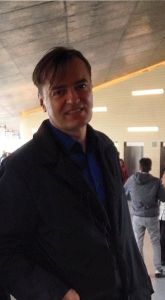
It was through these art exhibitions that Hadid met Patrik Schumacher, who would later become her business partner. An architecture student at the time, Schumacher later said, "I was intrigued by the frankness and openness of her presentation." Although Hadid herself never identified as a Deconstructivist, she retained an interest in its sculptural architecture made up of interconnecting spaces, characterized by dramatic angles, throughout the next decades. Her former tutor Zenghelis commented, "We called her the inventor of the 89 degrees. Nothing was ever at 90 degrees. She had spectacular vision. All the buildings were exploding into tiny little pieces."
Without compromising this bold style, in the 1990s Hadid began to transform her reputation as a "paper architect" to a building architect. Her first successfully realized project was the Vitra Fire Station in Weil am Rhein, Germany (1989-92). This was followed by more work in Europe, including a housing project in Berlin, exhibition spaces in London's Millennium Dome (1999), and for Weil am Rhein's horticultural festival (1997-99). The architect later referred to this formative period as "... the years when I didn't sleep for four nights in a row, or weeks ... It was a very exciting time."
The construction of two further projects in the late 1990s confirmed to her colleagues and clients that Hadid's designs were feasible, notwithstanding their ambition. These were the Rosenthal Center for Contemporary Art in Cincinnati, Ohio and the Bergisel Ski-Jump on Bergisel Mountain in Innsbruck, Austria. The New York Times called the former the "most important American building to be completed since the Cold War." It was not only Hadid's first American project, but also the first American museum designed by a woman.
A year after the completion of the art museum, Hadid was awarded the Pritzker Prize, widely considered to be the most prestigious architectural award. The president of the foundation, Thomas Pritzker, noted, "Although her body of work is relatively small, she has achieved great acclaim and her energy and ideas show even greater promise for the future." As the first woman to receive the prize, Hadid began to attract more media attention as well as higher profile clients with greater ambition and more substantial budgets.
Late Period
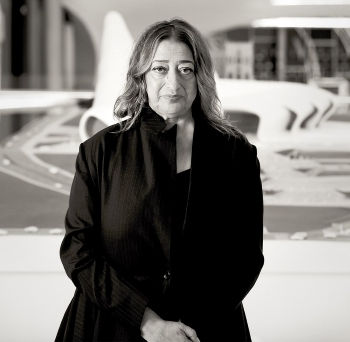
Having received recognition for her work, Hadid used her high profile to push even more ambitious designs. The first of these in a new style was the Phaeno Science Center in Wolfsburg, Germany (2005), which, by eschewing horizontals and verticals, gave rise to the development of new digital techniques to structurally engineer the building and compute its form. Hadid became a pioneer of this approach, which was termed Parametricism.
According to Schumacher, Parametricism "succeeds modernism as a new long wave of systematic innovation." It prompted a stylistic shift in Hadid's work, away from the jagged Deconstructivism for which she was previously known. The MAXXI museum of 2010, which was awarded the Stirling Prize, is one of her last works in the former style, while her design for the Heydar Aliyev Center in Baku, Azerbaijan in 2012 is characterized by the sweeping, curving forms of Parametricism.
Other critically acclaimed projects in this period include the Guangzhou Opera House of 2010 (inspired, according to The Guardian, by Hadid's unrealized designs for the Cardiff Bay Opera House of 1994), The Riverside Museum in Glasgow (2011), and the London Aquatics Centre (2011). The projects in Britain were her first to be built there, in spite of Hadid having become a British citizen and basing her practice in London. For this, she credits a new open-minded approach to architecture, noting, "Something has changed radically here [in Britain] recently. There is no resistance to the new any more."
For all those who praised Hadid's new architecture, other critics ridiculed the expense and scale of such projects. In many cases, Hadid was urged to scale back or abandon projects due to the constraints of sites or budgets. The London Aquatics Centre is a scaled-back design and a New National Stadium for the 2020 Olympics in Tokyo was discarded due to cost concerns. Her firm attracted particular criticism in 2014 after Hadid responded to reports of poor working conditions on construction sites in Qatar (where her Al Wakrah Stadium for the 2022 World Cup would be built) with the claim that ensuring safe working conditions was not her responsibility as an architect.
Death
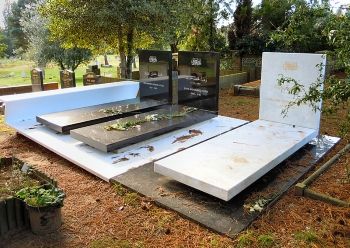
In 2016, Hadid died suddenly from a heart attack while being treated for bronchitis. She had decided not to have a family of her own and was entirely dedicated to her career. Speaking of her single-mindedness, she said that, "If [architecture] doesn't kill you, then you're no good ... you have to go at it full time. You can't afford to dip in and out." Some, such as the journalist Harry Mount, have described her professional devotion as "narcissistic." He wrote, "Her flat was empty, except for objects she'd designed herself: a curved sofa, a swooping table, and a futuristic tea set. There was little sign of pleasurable human occupation: no books, no CDs." Others argue that in dedicating herself to her work, Hadid challenged stereotypes of Muslim women and encouraged those who wished to, to do the same.
In response to being asked by journalist Simon Hattenstone in 2010 if she was happy being single, Hadid responded, "I don't think about it in this way. Things happen in life." Perhaps the closest Hadid got to a serious relationship was with her long-term design partner Schumacher. Their relationship has been characterized as close but "tricky." For example, Hadid's friend, the architect Peter Cook said, "[Hadid] was never really [one] to criticize Patrik, but she knew some of the things he was doing were not to her taste. But she was sort of semi in love with him and allowed him to do it." Nevertheless, any claims of a romantic relationship between them (including a rumor that they married in 2005) have been refuted.
Schumacher was the only non-family beneficiary of Hadid's will, which she entrusted to him, her niece Rana, and her good friends, the artist Brian Clarke and Conservative peer (and former chairman of the Serpentine Gallery) Lord Palumbo, to carry out. However, the relationship between the four has deteriorated since Schumacher's comments in 2016 advocating abolishing social housing and building over London's Hyde Park. In 2018, Schumacher launched a bid to take sole control of Hadid's estate. He has led Zaha Hadid Architects since the architect's death, on which she left behind 36 unfinished projects in 21 countries.
At the time of her death, Hadid was also in the midst of discussions with curator Hans Ulrich Obrist about an exhibition of her paintings. Having shown him her personal sketchbooks a year earlier, the curator recalled, "They were almost like doodles, but all her buildings seemed to come from the flow of these free sketches ... was very personal. She kept them in her bedroom. I was amazed and wanted to see more." The show took place in 2017 at the Serpentine Gallery, entitled Zaha Hadid: There Should Be No End to Experimentation. "She wasn't just a great architect, she was a great artist," according to Obrist.
The Legacy of Zaha Hadid
Hadid has been described by The Guardian as the "Queen of the curve," who "liberated architectural geometry, giving it a whole new expressive identity." Although she did not identify as part of a particular school, the terms Deconstructivist, Parametricist, and Abstractionist have variously been used to describe her work. Pritzker Prize jury chairman, Lord Rothschild, described her as, "unswerving in her commitment to Modernism. Always inventive, she's moved away from existing typology, from high tech, and has shifted the geometry of buildings." Likely influenced by her parents' progressive outlook, Hadid has, since her student days, "believed in progress and in creativity's role in progress" and has challenged traditionalism.
Upon her death in 2016, Hadid's studio reported, "Zaha Hadid was widely regarded to be the greatest female architect in the world today," begging the question of the relevance of her gender to her achievements. Hadid resisted typecasting as a female architect or an Iraqi architect for her own advancement, but was keen to reassure others that "they can break through the glass ceiling." Her commitment to encouraging younger professionals also came across in her teaching career. Once named among the world's highest paid architects, as well as an investor in property, restaurants, cosmetics, and fashion, many admired Hadid for her business acumen as well as her architectural ability.
Hadid's gender has undoubtedly colored the reporting of her work and personality by critics. Some, such as Mickey O'Connor, have perceived her confidence as "confrontational," and she is often dubbed a diva, a label she rejected as sexist. Others, like Mark Irving, pointed to her as a force to be reckoned with: "She cuts a dramatic, voluptuous figure in her black outfits ... above which large heavily lidded eyes and purple-painted lips that always seem to be set in a slightly unsatisfied pout, turn on you like the guns of a well-armored battleship."
Yet in Hadid's own accounts, she admitted to often feeling ostracized. This was the case particularly during the events of 1994 in which her competition-winning design for the Cardiff Bay Opera House was subsequently rejected. "People were patronizing towards me all the time. They didn't know how to behave with me. I don't know whether people responded to me in a strange way because they just thought I was one of those eccentric people, or they thought I was a foreigner or behaved funny or I'm a woman." On other occasions, Hadid has referred to herself as "flamboyant" and "eccentric...but I am not a nutcase."
Notwithstanding her feelings of exclusion from particular networking circles, the architect had high profile friends in, for example, Frank Gehry and Norman Foster. At her death, Foster noted "I became very close to her as a friend and colleague in parallel with my deep respect for her as an architect ... she was one of the very few architects as friends who was invited to my 80th birthday party ... she was my dear friend."
Michael Kimmelman of The New York Times adds that although "her soaring structures left a mark on skylines and imaginations," Hadid "embodied ... the era of so-called starchitects who roamed the planet in pursuit of their own creative genius." In line with the typical connotations of "starchitecture," or "star architecture," she has been criticized for the extravagance and celebrity of her designs. Critic Robert Booth has further suggested that favoritism and marketing value are the reason for her having won so many design competitions, rather than architectural talent.
Today, the Zaha Hadid Architects firm remains to carry out her legacy to create transformative spaces.
Influences and Connections

-
![Kazimir Malevich]() Kazimir Malevich
Kazimir Malevich -
![Frank Lloyd Wright]() Frank Lloyd Wright
Frank Lloyd Wright -
![Frank Gehry]() Frank Gehry
Frank Gehry - Elia Zenghelis
- Bernard Tschumi
-
![Rem Koolhaas]() Rem Koolhaas
Rem Koolhaas -
![Frank Gehry]() Frank Gehry
Frank Gehry -
![Norman Foster]() Norman Foster
Norman Foster - Robert Stern
- Peter Cook
- Zaha Hadid Architects
- Patrik Schumacher
-
![Anish Kapoor]() Anish Kapoor
Anish Kapoor - Patrik Schumacher
- Ron Arad
- Brian Clarke
-
![Deconstructivist Architecture]() Deconstructivist Architecture
Deconstructivist Architecture - Parametricism
Useful Resources on Zaha Hadid
- The Complete Zaha Hadid: Expanded and UpdatedOur PickBy Aaron Betsky
- Zaha Hadid Architects: Redefining Architecture and DesignOur PickBy The Images Publishing Group
- Hadid: Complete Works 1979-todayOur PickBy Philip Jodidio
- Zaha Hadid Complete WorksBy Patrik Schumacher and Gordana Fontana-Giusti
- Fluid TotalityBy Zaha Hadid, Patrik Schumacher and the Institute of Architecture
- Zaha Hadid (Inspiration and Process in Architecture)By Moleskine
 Ask The Art Story AI
Ask The Art Story AI









